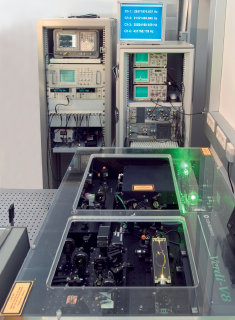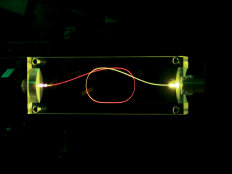Fundamentals
The meter
The meter (m) is the length of the path travelled by light in vacuum during a time interval of 1/299 792 458 of a second.

This definition of the unit of length valid since 1983 gives a fixed value for the velocity of light. Therefore the velocity of light can not be measured, the unit of length rather depends on the unit of time (second). At the BEV the realisation of this definition is carried out by an optical femtosecond comb generator. It is possible with this device to multiply the electric frequency given by the Cs atomic clock (which is a realization of the unit of time). This multiplication can be understood analogously to a mechanical toothed gearing: if the speed of rotation of the first wheel as well as the number of teeth of the other involved toothed wheels is known, also the speed of rotation of the last wheel is known with the same relative uncertainty. This principle of a mechanical clock work is also applied at the femtosecond comb generator, but here a frequency of 10 MHz is transformed up to approximately 500 THz, an transmission ratio of 1:50 000 000!

In co-operation with the Max Planck institute for quantum optics the comb generator of the BEV was modified, so that now almost each laser used in length metrology can be calibrated directly. The uncertainty of measurement to be achieved is essentially limited by the instability of the lasers to be tested, eventually also by the realization of the second.